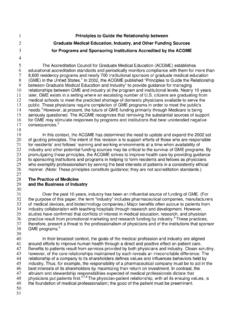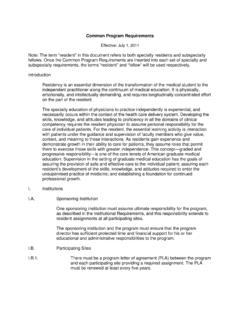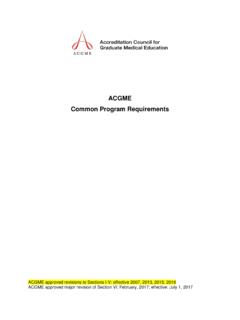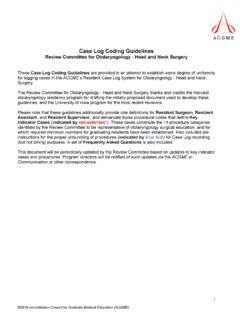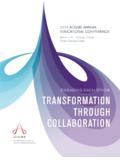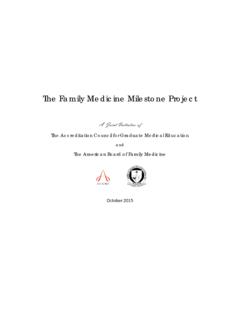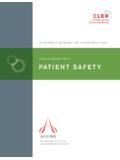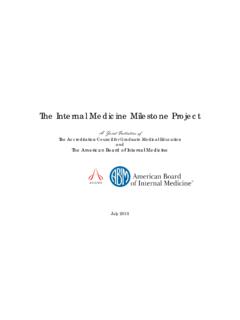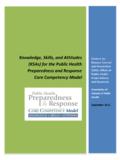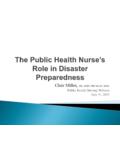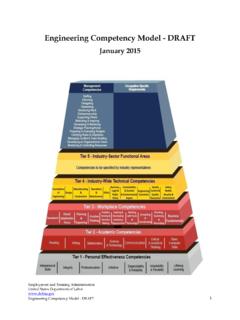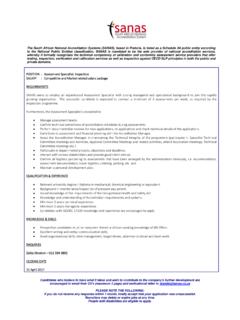Transcription of Clinical Competency Committees - ACGME
1 Clinical Competency Committees A Guidebook for Programs 3rd Edition Kathryn Andolsek Duke University Jamie Padmore Medstar-Georgetown Karen E. Hauer University of California at San Francisco Andem Ekpenyong Rush University Hospital Laura Edgar ACGME Eric Holmboe ACGME This information is current as of January 2020 Overview The Clinical Competency Committee (CCC) is a structure that has emerged as an essential component of the evaluation process in graduate medical education (GME). While some specialties and programs have utilized CCCs for years, this structure is still relatively new to many others. Likewise, with the emergence of the CCC as a requirement for accreditation ( ACGME Common Program Requirements), even seasoned programs and Committees are facing questions regarding the CCC s structure, function, and process.
2 Furthermore, scholarship on group decision making, assessment, and CCCs themselves continues to provide evidence to inform practices. The purpose of this manual, now in its third edition, is to provide designated institutional officials (DIOs), program directors, faculty members, CCC members, coordinators, residents, and fellows with information and practical advice regarding the structure, implementation, function, and utility of a well-functioning CCC. The materials were prepared for both individual learning and application in a group setting. Ideally, institutions and programs will be able to use these materials to have meaningful conversations with all stakeholders; enhance CCC development, function, and outcomes; and improve transparency for residents and fellows on the nature of assessment in Competency -based education.
3 This third edition also contains updated material and new tools for programs to use to continually improve their CCC processes, and a section on institutional opportunities with CCCs has been added. Each major section has an accompanying brief summary available as a separate, individual document. This manual provides information related to the following topics: 1. Purposes of a CCC 2. CCC Structure and Membership 3. Preparing for CCC meetings 4. Running the CCC meeting, including effective group process 5. Post-meeting feedback, documentation. and follow-up 6. Legal issues 7. Other Uses for the CCC 8. Individualized Learning Plans 9. Institutional Oversight of CCCs 10. Current Research Several appendices contain tools for institutions, programs, and CCCs. A robust body of research to support the various aspects of CCCs, including assessment, feedback, documentation, group dynamics, and outcomes, is now available.
4 An annotated bibliography is updated approximately every six months and is available on the Milestones section of the ACGME website. The ACGME welcomes feedback, and hopes this guidebook provides institutions, programs, and faculty members with valuable information and tools to enhance GME. 1 Table of Contents Sections Page 1. Introduction 2 2. Purpose of a CCC 5 3. CCC Structure and Membership 8 4. Preparing for CCC meeting 20 5. Running the CCC meeting 26 6. Post-meeting activities 36 7. Legal issues 39 8. Other Uses for the CCC 46 9. Individualized Learning Plans 50 10. Institutional Oversight of CCCs 56 11. Current Research 58 Appendices Page A. The High Performing Residency Assessment System 59 B. CCC Quiz 61 C. Case Studies 67 D. Designing the CCC 71 E. Examples of Assessment Methods for the ACGME Core Competencies 82 F.
5 Overview of Assessment Methods Aligned with Miller s Pyramid 84 G. PPV (Predictive Probability Value) Tables 85 H. ADAPT Model of Feedback 86 I. R2C2 Evidence-Informed Facilitated Feedback 87 J. Institutional Checklist for CCCs 89 2 Introduction The Clinical Competency Committee (CCC) became a central tool in graduate medical education (GME) as the ACGME transitioned to its current model of accreditation (previously dubbed the Next Accreditation System ) as an important element of Competency -based education. ACGME International ( ACGME -I) programs use CCCs as well. The requirements for CCCs have evolved with the most recently revised ACGME Common Program Requirements, effective July 1, 2019. All four sets of Common Program Requirements (Residency; Fellowship; One-Year Fellowship; and Post-Doctoral Education Programs) have the same requirements.
6 The ACGME has categorized all requirements for CCCs as Core requirements, meaning they are required for every graduate medical education program. The requirements are discussed in Part 2 of this guidebook. The objectives of this guidebook are to help institutions and programs: 1. Recognize the role and purpose of the CCC for individual programs in the ACGME s current accreditation model. 2. Design, create, implement, and continuously improve the program s CCC. 3. Run an effective CCC meeting. 4. Provide feedback to residents or fellows allowing for improved constructed individual learning plans. 5. Anticipate questions regarding process and considerations of academic law. 6. Align the program s own CCC processes with the best evidence from the medical education literature.
7 7. Use the CCC to continuously improve the program s curriculum, assessment system, faculty development, and Clinical training/experiences/quality. The guidebook also aims to help programs understand other opportunities for using Milestones data and for designated institutional officials (DIOs) to recognize opportunities to support CCCs at an institutional level. This guidebook is intended to be a practical resource and a professional development tool for institutional and program leadership, coordinator(s), and faculty members. Residents and fellows may also benefit from this guidebook, although a separate guidebook has been developed specifically for them: Milestones Guidebook for Residents and Fellows. Institutional and program leaders are encouraged to share these materials with their program faculty members and leaders, and to use the exercises as part of faculty and coordinator professional development.
8 These materials can be reviewed individually or as part of a meeting. The guidebook also provides suggestions for faculty development. The CCC contributes to an effective resident/fellow assessment system as outlined in Figure 1. In this figure, the CCC serves the critically important function of synthesizing multiple quantitative and qualitative assessments regarding individual resident/fellow performance. This figure highlights several important points: 1. The CCC s deliberative process will depend on the quality of the assessment program that should include a combination of assessment methods and a number of different assessors. Ideally, the individuals who sit on the CCC must 3 understand the basics of good assessment and the assessment tools being used by the program. Faculty members should have opportunities to enhance their assessment skills and understand how their assessments fit into the program s overall assessment strategy.
9 2. Residents and fellows are adult learners and must be active agents in this system; guided self-directed assessment behaviors by an individual resident or fellow should be expected and strongly cultivated. Programs are urged to encourage all of their residents and fellows to review the Milestones Guidebook for Residents and Fellows (available at ) 3. The program director of a residency, fellowship, or post-graduate educational program is the ultimate arbiter of whether a resident or fellow is ready to practice without supervision. The accountability of the program director and the program cannot be over-emphasized: professional self-regulation depends heavily on the informed judgment of education programs, as manifest by the final summative evaluation of competence and entrustment made by the program director.
10 4 Figure 1: Structure of a High Performing Resident/Fellow Assessment System Residents = both residents and fellows FB = Feedback loops D = Assessment data and information The model is more fully described in Appendix A In this model the Data Synthesis Committee IS the CCC. Holmboe ES, Yamazaki K, Edgar L, et al. Reflections on the first 2 years of milestone implementation. J Grad Med Educ. 2015;7(3):506-511. 2020. 5 Part 1: Purpose of a CCC The CCC serves several purposes for multiple stakeholders: the program itself, program directors, faculty members, program coordinators, residents and fellows, the institution, and the ACGME (Table 1). The ultimate purpose is to demonstrate accountability as medical educators to the public: that graduates will provide high quality, safe care to patients while in training, and be well prepared to do so once in practice.
